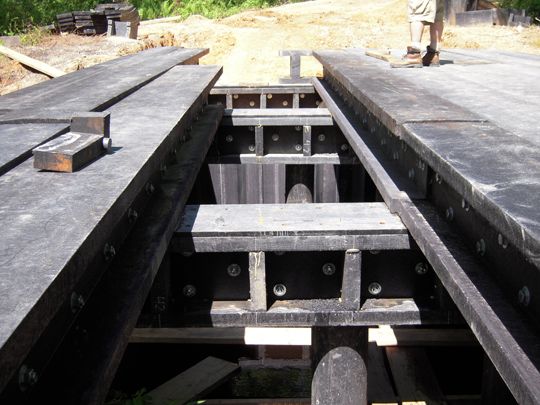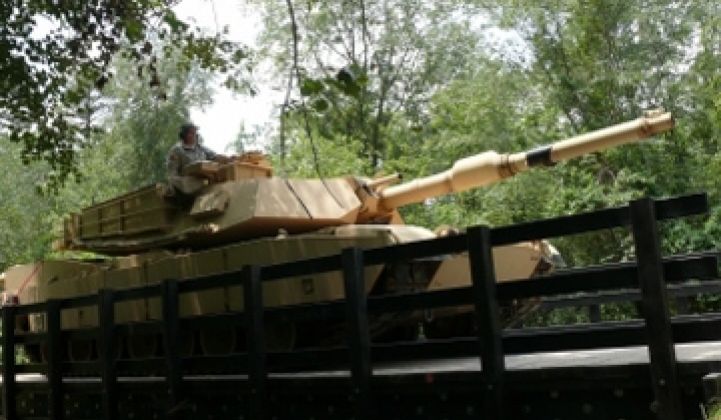Plastic – that ubiquitous, impervious, tough petroleum-based material – is becoming the green material of choice for a number of entrepreneurs, largely because it's impervous, tough and ubiquitous.
"Plastics were the Great Satan," said Jim Kerstein, CEO of Axion International (AXIH) which makes building components like I-beams and girders out of recycled plastic. "You could pull a milk jug out of a landfill and say 'Good God! This has been here since 1973.' But if you take a negative and turn that around with an application that requires longevity, that's a positive."
Two of the bridges built with components from the New Providence, N.J.-based company – which emerged from research at nearby Rutgers University –exist to support tanks at army bases.
It's not the only company heeding the siren song from The Graduate. Sollega next year plans to release the InstaRack, a modular, lightweight rack for solar panels made from recycled high-density polyethylene (milk jug plastic). Not only will the rack cost less to ship than conventional steel or aluminum racking, it comes pre-molded, thereby cutting installation work by up to 50 percent. It also won't corrode. In a similar vein, Ascent Solar and other makers of copper indium gallium selenide (CIGS) solar cells have or will soon move to plastic substrates.
Envion wants to produce synthetic petroleum from recyclables. As part of its sustainability initiative, Valley Forge Fabrics, which provides linens and fabrics to hotel chains, has started to make drapes from recycled plastic threads rather than new polyester.
"Natural fibers also don't meet the longevity requirements for hotels," says Diana Dobin, senior vice president of design and sales.
Like a lot of companies, IBM has moved to inflated plastic bags for shipping, says Richard Lechner, vice president of energy and environment at IBM.
Meanwhile, some startups hope to improve plastic recycling. Bioplastech, out of the University College Dublin in Ireland, has engineered a microbe that can eat oil from polypropylene and secrete a fatty acid that can be turned into a recyclable plastic.
And, of course, there are the bioplastic manufacturers. Cereplast has produced resins for consumer bioplastic for years while Metabolix recently announced that it was developing a strain of tobacco plants that generate polymers. Someday soon, communities may brag about being the Saudi Arabia of old milk jugs.
Many of these efforts serve as a way to get rid of the mountains of old plastic that humanity has generated. Plastic bottles have a low recycling value. As a result, some nations, like England and Ireland, tend to ship it to emerging nations, where it gets put into landfills. In Sweden and Germany, plastic gets burned as a dirty fuel. Interestingly, penalties can work: A 15 cent tax on plastic bags dropped their use by over 99 percent, Bioplastech CEO Kevin O'Connor told us last year.
At the same time, it's a somewhat economical feedstock, particularly when avoided landfill costs and taxes are added. Prices vary by market conditions and quality, but it compares well against metals, adds Axion's Kerstein. (Recycled plastic is comparable to virgin plastic around the $75 per barrel price of oil, says conventional wisdom.)
Kerstein further added that plastic helps architects and contractors reduce the energy required to build and maintain large structures. Overall, a bridge made from plastic components weighs 40 percent less than one made from traditional counterparts, which leads to 25 percent to 30 percent lower overall costs.
"It takes less energy to produce our materials than it takes to produce wood or mill steel," he said. (His calculations look at the energy consumed from when the raw material – plastic, wood and steel – arrives at a plant to when it gets turned into a board, beam or piling.)
Plastic components also don't have to be painted, won't corrode, and won't get worn down by the elements. The building components can also come in a variety of colors. The Army likely won't want hot pink siding with floral patterns, but you might someday.
Engineers at Fort Bragg and Fort Leonard Wood have installed bridges made from Axion's components built to carry tanks. The bridges are rated to carry 73 tons worth of tread vehicles or 84 tons worth of four-wheeled trucks. The Fort Bragg bridge consists of 85,000 pounds of plastic, or 550,000 milk jugs.
Skeptics come with the territory. When the Army first tested the Fort Bragg bridge, it also brought along a crane on another truck, Kerstein recalled. That was just in case the tank fell in and had to be plucked from the gully. It wasn't needed.
About 200,000 plastic railroad ties, made from 1.5 billion tons of post consumer plastic, have been produced and some have been in constant use at a test track in Pueblo, Colo. If you've driven in New Jersey's Wharton State Forest, you may have crossed over a 56-foot bridge made from Axion's components.
How does it work? Axion first grinds down the plastic and melts it into a hot Play Doh-like substance, when it can then be manipulated into shapes. When it cools, a building component is born. Axion can work with different types of plastics, but typically a single type of plastic will be used in a component.
"Saying plastic is like saying wood," he said. "There is a big difference between yellow pine and tropical hardwoods."
Overall, the strength of the finished product (compared to steel or wood) is not much of an issue, he said.
"We need to work on absolute stiffness. Steel, cement and wood are substantially stiffer," he said.
Axion bypasses this problem through design. A bridge made with interlocking plastic I-beams might be supported by a larger-than-normal number of pilings, or the pilings might be sunk deeper than normal. In the end, the resulting structure costs less and takes less time to build but exhibits the same integrity, he said.
Kerstein, who had worked in plastics for years, read about research conducted by Tom Nosker at Rutgers. "Being the Jersey guy that I am called him up to have a beer," he said.

A close up of the plastic bridge at Fort Bragg.



